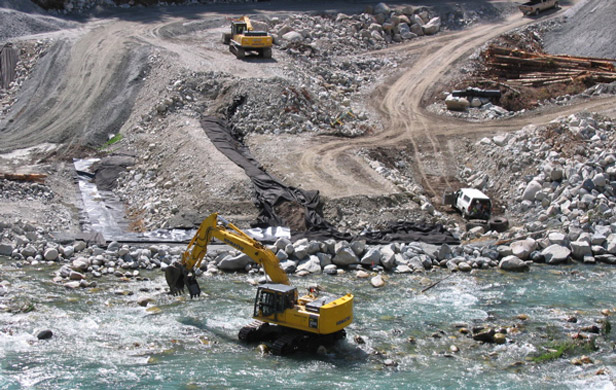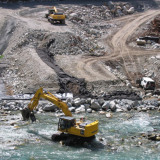
The following article by renknowned energy expert and SFU economist Dr. Marvin Shaffer is republished from the Canadian Centre for Policy Alternatives’ Policy Note
You would think that the fiasco of the government forcing BC Hydro in recent years to buy run-of-river and other IPP supply that it didn’t need, resulting in losses of hundreds of millions of dollars per year, would have put that unfortunate policy on the back burner for a long time.
Not so. Clean Energy BC, the lobby group very ably representing IPPs in the province, has released a report claiming that BC Hydro could save $750 million to $1 billion if it were to buy a basket of run-of-river, wind, biomass and other IPP supply instead of building Site C. And apparently Minister Bennett is looking at that option as an alternative to Site C.
No reason to believe private power lobby
There is, of course, little reason to believe IPP supply would provide cost savings of $750 million to $1 billion relative to Site C. The estimates of such cost savings assume that IPP supply can be secured by BC Hydro at an average cost of $74/MWh, some 40% less than the average $125/MWh price BC Hydro contracted to pay after its last call for new supply.
The estimated cost savings also ignore the relatively low value of run-of-river and wind supply, run-of-river because of the disproportionate amount of energy produced in the springtime and wind because of the intermittent nature of the supply and consequent need for constant back-up. And, the estimated savings ignore differences in the cost of capital between publicly financed and private supply, and differences in the contractual rights to the projects at the end of initial contract periods.
From bad to worse
One can only hope that Minister Bennett does not jump from one bad idea (building Site C even though BC Hydro does not need that supply in the foreseeable future) to an even worse idea (acquiring high cost, low value IPP supply that we equally don’t need).
There is a far better strategy that BC Hydro should pursue.
What Hydro really needs
What BC Hydro really needs in the short to medium term is back-up for its hydro-electric system — assurance it will be able to meet all of its requirements even in drought conditions when hydro production is constrained. As well it will need more peak generating capacity — the ability to meet requirements in very heavy load hours periods.
The most cost-effective way to meet those needs is with the installation of additional generating capacity at BC Hydro’s existing hydroelectric plants — the so-called Resource Smart projects — and with strategically located natural gas turbines — available if needed but otherwise not run. The IPP run-of-river and wind projects don’t provide what BC Hydro needs and while Site C could, it would provide far in excess of what is required.
Minister Bennett would do well by deferring the development of Site C. Maybe one day it will be needed and a case could then be made that it is in the broader public interest notwithstanding the very legitimate objections of those most directly impacted by the flooding it entails. But it isn’t needed right now.
And nor is a return to the forced purchase of IPP supply. Been there. Done that. Don’t need to do it again.


and so since bloombergs is writing about this stevie thinks it important to reiterate his slash and burn mentality to the nation and his people on wall st
IPP parasitism was designed to be almost impossible to cure past a certain point after inoculation, and to persist as a chronic parasitic infection even if remedial action is applied after that point. In many ways IPPs have proven a superbly clever tactic by the master neo-rightist Gordon Campbell: though designed ultimately to kill the publicly owned BC Hydro host so’s to divide its huge revenue potential amongst privateering vultures, it can alternatively pay them handsome “profits” in the interim should another government try to keep the host alive, some of which is returned to the BC Liberal party as the favouring agent; in effect, IPPs provide a vital revenue stream that can finance both the maintenance of the current BC Liberal government and the campaign for a future BC Liberal government to regain power should the electorate replace this one with another party—even if that party attempts to undo the longterm IPP contracts. It’s a win-win for the BC Liberals and their insider friends whether the death of BC Hydro is quick or slow.
This isn’t merely an opinion held by me and many, many others, including former BC Hydro executives. IPP are irrefutably parasitic in every way: they cannot exist as enterprises “free” to succeed or fail competitively because the power they produce is vastly more expensive than BC Hydro’s, and they can only survive by massive subsidy the public power producer is forced this highly ideological and conflicted government. And that subsidy is huge enough to kill BC Hydro. But the parasitism also extends to the environment, to individual customers (who are actually shareholders vis a vis citizenship) and, ironically, to corporate customers who are supposed to be supporters of the “free enterprise” the BC Liberal government fraudulently imitates. Even the partisan dichotomy BC Liberals pretend exists cannot absolve the fact that such parasitism will render BC Hydro incapable of fulfilling its mandate to provide affordable electricity to citizens and industry. But that was never their true interest anyway.
If BC Hydro needs to do anything, it’s to get rid of IPPs, pointe finale. The environment and both civil and corporate economies are better served by doing so. It’s almost incredible that such stupendous parasitism and such diabolical intent can exist, but it does. And if there’s any help for that, it has to include action against IPPs, if not immediately, then soon, else it will be very difficult to get done—which, of course was the architect’s intent. But It must be done, there’s really no argument.
So the first question is really whether the inoculant has already passed the chronic-remedy point or is still in the acute-cure phase. Until all legal opportunities are prosecuted, statutory and Constitutional, I would argue that the political front is not yet the only one. A simple example is the potential to abrogate existing IPP licenses for contractual breaches with regard to environmental regulation which are known to commonly exist at many IPP sites; if the Crown refuses to prosecute, it must fall therefore to other litigants. That might be ordinary citizens, but that should also include corporate interest which definitely have a stake in ending costly parasitism of BC Hydro by insider BC Liberal friends. While political action will ultimately be required, the failure of the NDP Opposition shows this route to be too slow. There is this other option, and for the sake of expediency, it should be pursued soon.
Then, when the parasites are either cured or remedied, we can get on with developing electric power policy for the future. We can’t do it otherwise.
Mostly I like the analysis, there are a couple of things that I think are important. Conservation, there is a huge oversupply of electricity in BC if we seriously conserve and get more efficient. Given the need to raise rates, no matter what alternative we pursue for future generation, the opportunity for improved conservation attitudes and technologies will only get better.
With conservation then, the need for a large block of power is delayed and stretched out. While small gas plants have the potential for meeting peaking and emergency needs, so do IPPs, and given the reduced need for a large supply system I think that IPPs could be selected on the veracity of their costing analysis, and introduced one at a time to ensure minimizing expense to the BC Hydro customer.
A lot of IPP’s haven’t even started construction yet, even though they are well into the approval….er……rubber stamping…..process. The alpine lake draining Narrows Inlet project on the Sunshine Coast is a prime example of a goofy project that Bennett and Polak are letting proceed. It isn’t even started construction yet and has very little chance of meeting it’s contractural obligation to BC Hydro for the commencement of delivery date. Unless they pay penalties. The fact they are willing to pay penalties for late delivery shows just how much money is in it for them.
That is a good comparison of the IPP vs gas plant vs megadam options. BC does have additional opportunities to meet its future electricity needs. The single most important one, the one that will avoid all the environmental damage, put off expensive financial investments, and make us all a little more aware of the different impacts of our energy use, is a serious government and industry conservation program.
Many developed nations use 1/3 to 1/2 of the power/person that we use. This means that we currently have twice the electricity production capacity that we need. Anyone who thinks we should be flood destroying river valleys because of ‘want’ rather than need should reconsider.
Right on!
I cringe everytime I see another one of these “run of river ” projects. Regardless of the infrastructure involved to deliver the sporadic power to the BC Hydro grid. This must have a debilitating affect on salmon runs.
I was in Quebec and the Maritimes last summer and they have really jump into Wind Power in a huge way. My cousin works on building commercial wind towers and then maintaining them. They are very heavily govt regulated . ie Lands and Forests. They actually have “bat software” to slow the blades down at sunset and sunrise when bats are their most active.
These windmills are technically complicated, expensive units. He wasnt too happy with me when I asked him what their efficiency was compared to solar. Ah well, Devil’s advocate…;)
You can guarantee that Minister Bennett will choose the worst possible option for the citizens and the best possible option for the IPP corporations. These crooks are looking to turn over a fast buck by forcing the politicians they have bought and paid for to purchase their inefficient operations at about double what they put into it, thus making huge profits and making the taxpayer pick up the tab. This is exactly the type of deal the Lieberals specialize in.
Yes indeedy, Lieberals are greedy like Bennet’s eyes are beady. Recall the humorous little red book intended to laugh Premier Bill Vander Zalm out of office, doubtlessly contributory to that actuality (with all due respect to Bill’s heroic sponsorship of the Anti-HST crusade 20-odd years later…)
I bet something similar could be penned starring old spittle-face Bennet, who has been very, very generous with eligible quotations.
**********************************************************************************************
S.Osbourne & M.Schendlinger. Quotations From Chairman Zalm. Pulp Press, Vancouver, 1989
🙂 You mean like our good energy ministers quote in the Alaska Highway news, about the BC Utilities Commission never having looked at a big issue like Site C before? HAHA The Commission was created to look at Site C in the 80’s and the dam was turned down then because of that hearing. Lordy where do they come up with this stuff.